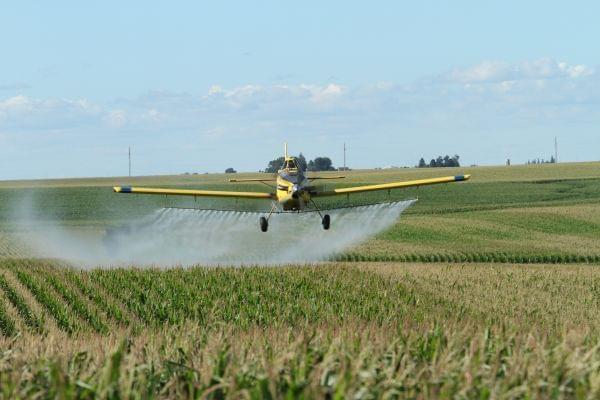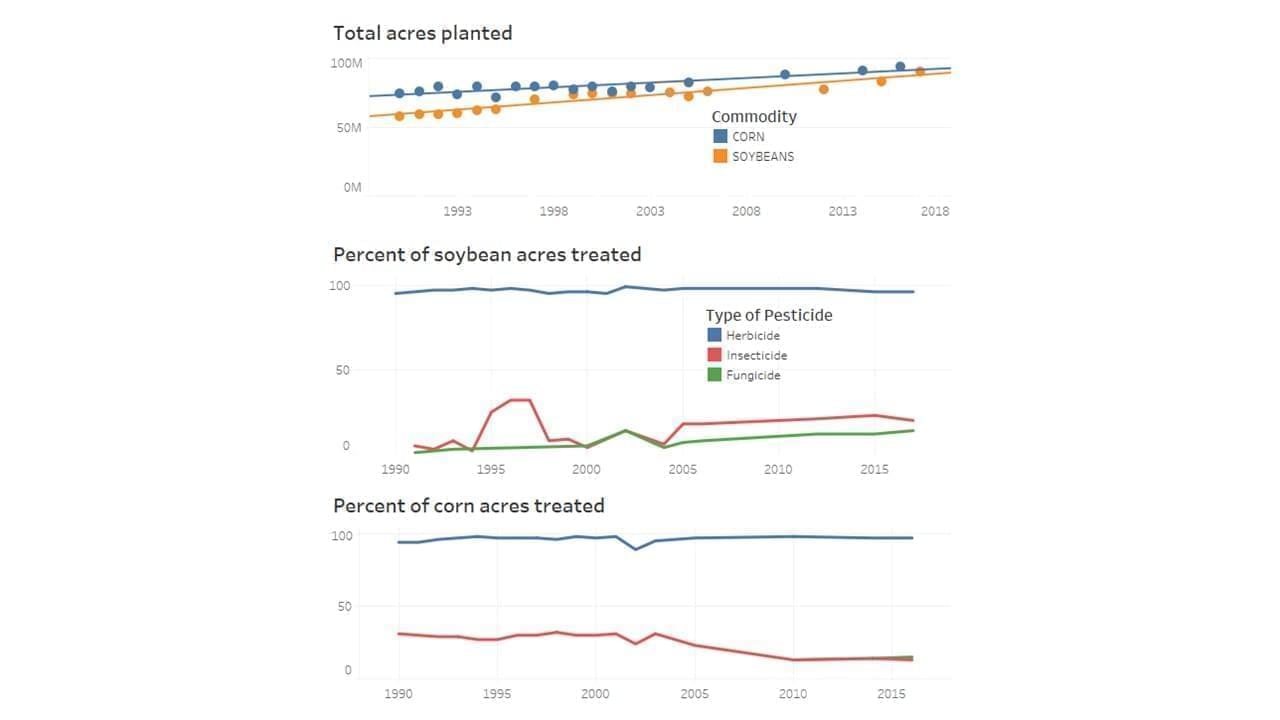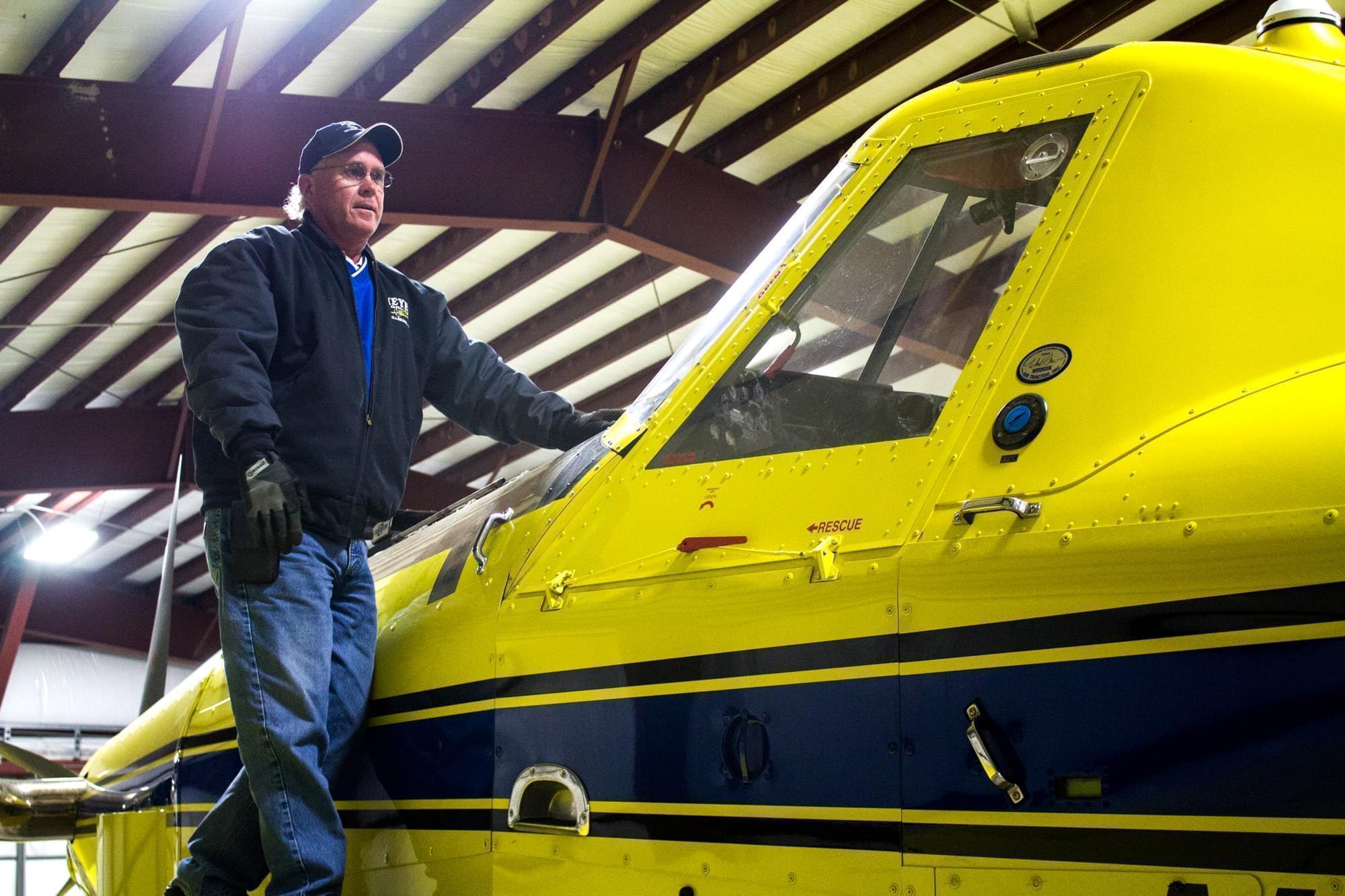Across Midwest Farm Fields, Pesticide Exposure Is Tracked Unevenly Or Not At All

Fleets of specially-equipped planes can spray pesticides on cropland, including this Air Tractor owned by Meyer Agri-Air in Wellsburg, Iowa. Courtesy of Meyer Agri-Air
On July 28, 2017, a central Iowa emergency dispatcher received a 911 call from a man in a corn field.
“I had workers that were detasseling,” said the caller, referring to the job of manually pulling the tops off standing corn stalks. “Some may have gotten sprayed by a plane.”
The caller said 10 or 12 people reported sore throats or vomiting. They’d seen a plane applying pesticides to the adjacent soybean field and it seemed some of the chemicals had drifted toward the corn and onto the workers.
Cody Lawrence, an agronomist with Monsanto (now owned by Bayer), was about 20 minutes from the site, which was not a Monsanto field. He quickly hooked up a portable shower trailer — known formally as a decontamination unit — and headed east.
“As far as what I could see, everybody was calm, it wasn't frantic,” Lawrence recently recalled of the scene upon his arrival. “Everybody appeared to have a purpose in what they were doing.”

Cody Lawrence, an agronomist with Bayer in central Iowa, models the disposable coveralls that are given to workers to wear after contact with pesticides requires them to strip off contaminated clothes and wash up.
The textbook response turned something that could have had devastating health impacts into a minor inconvenience. But with a billion pounds of pesticides applied to crops every year, the risk to workers is real and a Harvest Public Media investigation has found no agency or department keeps national records on how often such accidents happen.
Recordkeeping varies so much that collating a national list using data from states is impossible.
Pesticide ubiquity
In 2017, about 459 million acres of U.S. agricultural land were treated with some kind of pesticide. The vast majority — upward of 95 percent — of corn and soybeans are treated with an herbicide, which kills weeds. Other pesticides that kill insects or fungi are used less widely in major field crops.

Data: U.S. Department of Agriculture; data analysis by Andrew Kniss at the University of Wyoming
Every state has a designated “lead pesticide agency,” which is responsible for enforcing federal and state regulations. Some of those keep track of “misuse incidents,” such as unlawful applications or products drifting beyond their intended targets. But the agencies don’t necessarily distinguish accidents involving human exposure from those that affect crops, trees and other plants.
Harvest Public Media asked the departments of agriculture in Colorado, Illinois, Iowa, Kansas, Missouri and Nebraska how many worker-exposure incidents were reported between 2013 and 2017. Officials in Iowa, Nebraska and Colorado were able to answer.
But Missouri said its agriculture department does not track incidents "to that level of specificity.” Kansas said it had no reports of such incidents, adding “(i)t is possible that complaints related to illness in workers may have been reported to the Kansas Department of Health and Environment, but we assume they would have notified us if they expected any connection to agricultural products.” The Kansas Department of Health and Environment did not respond to Harvest queries.
Denise Albert of the Illinois Department of Agriculture responded to our inquiry with, “we do not track that information.” She suggested contacting the National Pesticide Information Center, which operates a consumer hotline.
National Pesticide Information Center call logs for the same set of states over the same period of time, provided through an open records request, show the number of calls from people concerned about exposure is higher than the cases documented by most state ag departments.
That’s no surprise: The calls are self-reported incidents; the information is not vetted or verified; and the concerns are not restricted to agricultural uses or worker exposure. Also, callers are typically looking for information about how to clean up from a suspected pesticide incident and they don’t necessarily report what happened to a state agency.
Still, some calls were about agricultural pesticide use, including statements about people being exposed and experiencing symptoms. But hotline calls could not be correlated to incidents reported to the state agriculture departments.
The Centers for Disease Control has operated a pesticide surveillance program to document cases of human exposure. The Iowa Department of Public Health participated in it until grant money ran out in 2015. The program lists 13 participating states, including Illinois and Nebraska, though the website was last updated in 2017 and still includes Iowa. Iowa health department spokeswoman Polly Carver-Kimm said the state continues to look for other funding streams, but she said the data collected through the program was never publicly available.
The CDC also works with the nation’s poison control centers to aggregate data on pesticide exposure reports, but that’s not specific to agriculture nor workers.
The investigation in Iowa
For the detasselers in Iowa and the two million other agricultural workers, the widespread use of these chemicals raises concerns about on-the-job health and safety. Many of the products, including the two that drifted that summer day, are expressly labeled: “Do not apply this product in a way that will contact workers or other persons, either directly or through drift.”
“The label is the law,” said Gretchen Paluch, pesticide bureau chief at the Iowa Department of Agriculture and Land Stewardship. “And all the information on that label is absolutely essential.”
Her department can only investigate misuse incidents — whether they involve human exposure or not — if they know about them. In the case of the 2017 detasseling crew, Paluch said news reports that day brought the situation to her bureau’s attention.
“We're not a 24-hour emergency response service,” she said in an interview. “If there is an emergency we always direct people to contact emergency response. But we did get out there that day.”
Pesticide bureau investigators documented the types of pesticides the plane had in its tank, which were the BASF fungicide Priaxor and Lambda Select insecticide, and took samples. They found residue on hats, clothing and plants in the field. Paluch said that initial investigation was completed quickly.

Iowa Department of Agriculture Pesticide Bureau Chief Gretchen Paluch says her department can only investigate pesticide accidents if they know about them.
Deciding on the appropriate legal action took 18 months. In January 2019, the Iowa agriculture department proposed a settlement with the pilot and his employer, Woodley Aerial Spray. Two months after that, Woodley agreed to pay a $2,080 civil penalty for “the application of a pesticide contrary to its labeling; application of a pesticide in a faulty, careless or negligent manner, endangering people’s health and their environment; and the failure to comply with the record-keeping requirements for commercial applicators.”
The pilot’s certification to apply pesticides was suspended and he is no longer working for Woodley. Craig Woodley, president of the company, told Harvest Public Media he did not wish to comment on the incident or the settlement. Harvest was unable to make contact with the pilot.
Communication in the fields
Many farmers hire a commercial pesticide applicator, like Woodley Aerial Spray, to bring chemicals to their crops. According to the National Agricultural Aviation Association’s 2019 industry survey, 127 million acres of cropland are treated with aerial applications each year. That’s up from about 101 million acres in 2012, when the association last counted.
At Meyer Agri-Air in Wellsburg, Iowa, founder Joel Meyer and his staff have written a safety manual and imposed specific guidelines that exceed federal and state requirements for protecting workers from overhead spraying. Meyer said pilots flying the company’s seven agricultural planes and one helicopter must do a fly-over of the entire field plus a one-mile radius around it before they begin applications.
“They circle it, and they look inside the field and they’re looking, of course, outside the field,” Meyer said, “and then once they deem it safe, then they’ll start the operation.”
But even before the pilots head out in the morning, the office staff reach out by phone and email to companies they know of that might have workers in or near fields on the day’s spraying schedule.
“We establish who our field person is we’re going to talk to, or who it is that’s going to be giving us information. We have all that written down and established before the season even starts,” said Heidi Beving, business manager at Meyer Agri-Air. “So then we can have a good working relationship with them on where they’re going to be and where we are.”
The company also requires the entire staff, including those who normally work in the office, to take the state’s training for pesticide handlers. (Pilots take a more specific training.) That way, Beving said, any of the staff can help with mixing or loading chemicals if needed.
Federal and state regulations require pilots and handlers to complete a written test and maintain their certification through either an annual training or an additional test every three years. But Meyer, who is president of the Iowa Agricultural Aviation Association, said he would like the state do more.

Pilot Joel Meyer, founder of Meyer Agri-Air, is currently serving as president of the Iowa Agricultural Aviation Association and hopes to get stricter rules in place for preventing accidents.
“We’re hoping that with us meeting with Iowa Seed Association that we find a way, whether it’s in the licensing or the continuing education process, that some of these measures can be put into place,” he said.
Kenny Brophy, a commercial pesticide applicator who works for MFA Agri Services in southern Iowa and parts of Missouri, said the most important thing for ground applicators to remember is to slow down and do things the right way.
“It’s easy to get wrapped up in hurry, hurry, hurry,” he said.
In 34 years of applying pesticides, Brophy said he’s only had one or two incidents where he made a mistake, once causing damage to someone’s garden plants. He’s never had an incident where pesticides he’s working with have landed on people.
“You learn to pay attention and see what’s going on,” he said.
But workers have no way of knowing whether the applicators spraying near them take that kind of time, and the public, too, is in the dark about how often pesticide spraying goes awry.
For more on the law meant to protect agricultural workers from pesticide dangers, and the EPA’s admission that good incident data does not exist, read Part 2 of our series, publishing May 15.
Part 3 of our series, which will publish May 16, will look at how states with legal marijuana are navigating pesticide use and safety while it remains illegal at the national level.
Follow Amy on Twitter: @AgAmyinAmes
Links
- Wind-Blown Pesticides An Issue In Courtrooms, Communities Across U.S.
- Pesticide Applicators Report Drift Issues With Dicamba
- With Conventional Farmers Embracing Dicamba, Specialty Crops Likely Next In Line For Damage
- Experts: Dicamba Will Come For Trees, Specialty Crops In 2019
- Ag Panel To Discuss Dicamba Impact
- Complaints Surge About Weed Killer Dicamba’s Damage To Oak Trees

